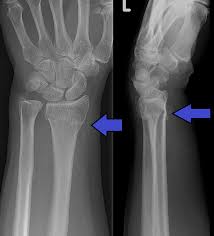Most of us will know of someone who has had the unfortunate experience of having a broken wrist. Most commonly a wrist fracture will be the result from a trip or fall on an outstretched hand.
Our wrist is made up of two long bones in the forearm – the radius and the ulna and a group of smaller carpal bones.
The radius is the larger forearm bone which takes most force when falling or bearing weight through the wrist. As a result, it is a radius fracture that is one of the most common types of fractures seen by emergency departments, orthopaedic and GP clinics.
These types of fractures can vary greatly depending on the severity or nature of the injury. For a severe fracture, surgery if often required to realign the radius and to stabilise the bone.
For the less severe injuries, they are managed successfully taking a conservative approach of splinting or immobilisation prior to a period of rehabilitation and strengthening.
Regardless of the severity of a distal radius fracture, the role of hand therapy is most important in the management and rehabilitation of the arm, wrist and hand.
Conservative management.
Conservative management of a fracture means that surgery is not required but that your wrist needs to be immobilised or kept still for a period of weeks to allow the fracture to heal on its own.
As per a previous blog entry, Geelong Hand Therapy now offer lightweight waterproof fibreglass casting which is a fantastic alternative to a heavy plaster cast. This can eliminate difficulties with showering, enable better functional use of the hand and fingers, and reduces issues relating to shoulder and elbow pain from the weight of a heavy plaster.
We also offer alternative options for splinting the wrist with removeable custom made wrist splints depending on what is required for your fracture.
Your wrist is typically immobilised for up to 6 weeks in a cast of splint, after which you will be provided with exercises to regain the movement and strength in your wrist, tailored to your individual needs.
Following surgery.
If your fracture requires surgery, often a metal plate and screws will be used to hold the fracture in place. Following an operation, you will most often be sent home in a plaster for the initial few days to 2 weeks.

It is very important, however, that after surgery for a distal radius fracture that movement exercises for the wrist are started very early in your recovery to prevent significant stiffness. It is possible to move your wrist much sooner after surgery compared with conservative management because of the stability that the metal plate and screws provides.
Much like conservative management, you will be guided through a progression of exercises to regain movement and strength of the wrist as well as being given advice and guidance regarding wound healing and scar management.


At times, with the force of a fall, we not only do damage to the bone but we can also disrupt or cause injury to the soft tissues that support the wrist. This can include ligament injuries which can cause persistent pain beyond what most people might expect following a broken wrist. The therapists at Geelong Hand Therapy will be able to assess whether your injury extends beyond just your fracture and will provide you with the appropriate supports and exercises specific to your injury.
Like most injuries, everyone responds differently and recovers at different rates. The team at Geelong Hand Therapy will be able to design a rehabilitation program specific to your symptoms and stage of recovery to get you back to work and doing your day to day activities!




